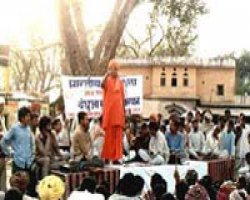
Bandhua Mukti Morcha or Bonded Labor Liberation Front was formed in 1981 to rid India of the scourge of Bonded and Child Labor. Since then it has dedicated its activities to the release and rehabilitation of the bonded laborers who lead a hellish life of bondage, slavery and debt. Till date BMM has been instrumental in the release and rehabilitation of 1,78000 bonded laborers (including 26,000 child bonded laborers).
BMM is registered under the Societies Act, 1860. It is also registered with Ministry of Home Affairs for Foreign Contribution Regulation Act.
Slavery persists in our age in various forms. The bonded labour system is one of them. Child labour is another kind of bonded labour. Both arise out of socio-economic and historical reasons. India, the largest democratic country in the world, has 65 million potential bonded child labourers, and 450 million adult labourers living a life of bondage and contemporary forms of slavery, according to our estimates. This is despite Constitutional guarantees and prohibitive laws like the Bonded Labour System (Abolition) Act 1976, the Child labour (Prohibition and Regulation Act) 1986 and International Conventions on the subject. Child labour (5 years to 14 years of age) is rampant not only in agriculture but also in industries such as those manufacturing matches, locks, carpets, stone quarries, brick kilns, tanneries and diamond cutting and polishing units. These children are denied their fundamental right to childhood, to education, to play and to dream like a normal child. They have to labour for more than 8 hours every day. Legal and human rights battles on their behalf have been successfully fought in the Supreme Court of India. Parliament too has been approached. United Nations Human Rights Commission, ILO and UNICEF have been sensitised. Yet, the 33 year-old struggle is only a beginning. A lot more remains to be done.
BMM was the first organization to crusade against this pernicious bonded labour system in India. Administrative and political will to carry out the Constitutional mandate and enforce prohibitive laws of the land failed to produce any results. It was on the historic PIL of BMM that Justice P N Bhagwati delivered his epoch making Landmark judgement declaring that all labourers who are denied common minimum wage, are bonded labourers(3SCC 1984). Against all odds, Bandhua Mukti Morcha has achieved the release of over 1,76,000 bonded Indians from the shackles of slavery. A large number of them have been rehabilitated. From the Carpet Industry alone, about a thousand children have been rescued and restored to their parents. Their rehabilitation has been monitored effectively. BMM has started a campaign for the provision of non-formal, full time education for these children, along with the supply of nutrition to each and also some food security to their poor families.
As a result of BMM’s efforts, the leaders of the leading political parties have expressed their concern on the issue of child labour and often made a mention of it in their election manifestos in Parliamentary elections. Bandhua Mukti Morcha has been campaigning for a national minimum wage equivalent to first-day salary of a class IV employee in Government service. Its revision is to be done on cost price index as is done for the Government employees. The State Governments may fix minimum wage according to the local conditions but not below the National Minimum Wage.
Bandhua Mukti Morcha has been making a demand for a National Commision on Bonded Labour with judicial and financial powers. But successive governments have failed to do so. Bandhua Mukti Morcha has, therefore, constituted a Citizens’ Commission on Bonded and Child Labour, with eminent persons of political, social and judicial integrity as members. They include former Judges of the Supreme Court of India, eminent artists, journalists, lawyers and social activists. It has also been observed that about 90 percent of the Bonded Labourers are from SC and STs and thus BMM has been relentlessly engaging members of these tribes and communities in various creative tasks for their holistic development.
During the last 34 years BMM has been working for the holistic amelioration of the society and thus waging battles against Casteism, Substance abuse, discrimination against women (abominable Sati or bride burning, Gender discrimination and female foeticide, child marriage, rapes and domestic violence) religious fundamentalism and obscurantism, oppression, corruption, communalism and terrorism etc.
Bandhua Mukti Morcha Vs Union of India and Others , 1984 3SCC 161 :- “Therefore, whenever it is a shown that the labourer is made to provide forced labour, the Court would raise a presumption that he is requires to do so in consideration of an advance or other economic consideration received by him and he is, therefore, a bonded labour (for detail please see Annexure-I ‘’Who is bonded” by T.N. Shankaran) This Presumption may be rebutted by the employer and also by the State Government if it so chooses but unless and until satisfactory material is provide for rebutting this presumption, the Court must proceed on the basis that the labourer is a bonded labourer entitled to the benefit of the provision of the Act. The State Government cannot be permitted to repudiate it is obligation to identify, release and rehabilitate the bonded labourers on the plea that thought the concerned labourers may be providing forced labour, the State Government does not own any obligation to them unless and until they show is an appropriate legal proceeding conducted according to the rules of adversary system of justice, that they are bonded labourers”